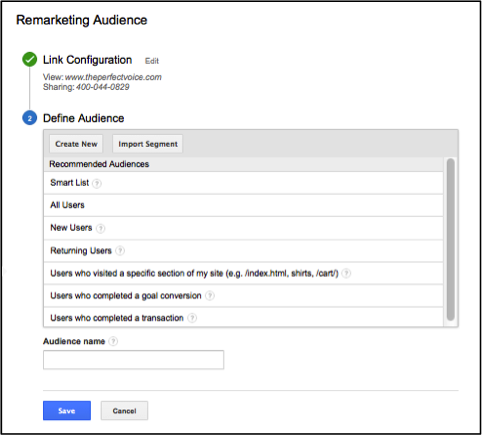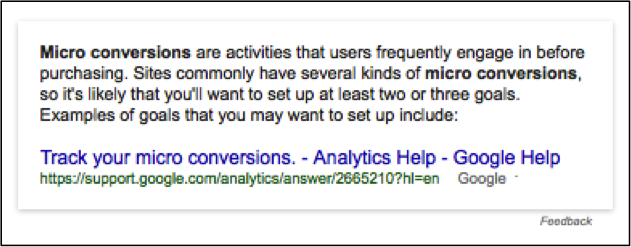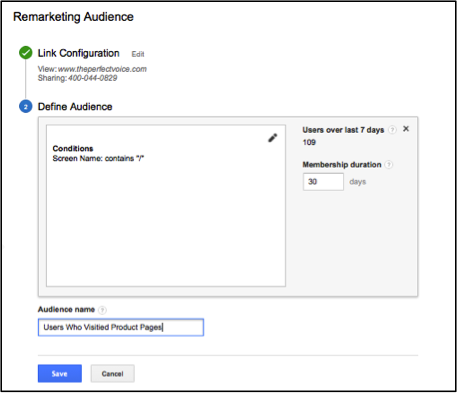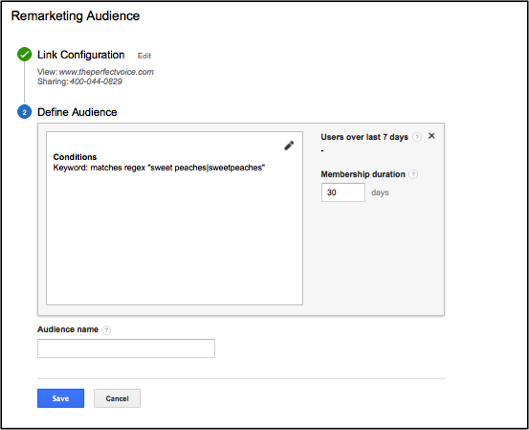Digital analytics is entirely about discovery. As data analysts we are pursuing fresh insights we can turn into actionable business improvements. Campaign optimizations such as improving the click-through rate of your ads, or reducing cost-per-click are great places to start. Today I am going to cover a fantastic way to focus on your customers using Google Analytics data.
Using the data that is already in Google Analytics, you can remarket to your site visitors. This feature of Google Analytics is called Google Analytics Remarketing. As you will soon read, the list creation process in Google Analytics is significantly improved over the list creation in Google AdWords.
One enormous benefit of using Google Analytics Remarketing is that you are effectively designing your marketing campaign using data straight from Google Analytics. This data is collected based on Google Analytics ABCs (Acquisition, Behavior, Conversions) data. Creating lists based on many customized metrics will allow you to get more targeted and better segmented ads based on your business goals.
Google Analytics Remarketing Explained
Google Analytics Remarketing lists can be used to build campaigns that run in the Google Display Network (GDN). Using the data out of Google Analytics you essentially define the audience list and highly tailor these lists.
You can segment based on onsite behavior, actions and/or conversions. Lists can be comprised of users browsing a product category, or lists can be based on user categorization such as a new or returning visitor.
Once you have created this list Google Analytics communicates with Google Adwords so you can create your campaign. You need to have a list size of at least 100 visitors to create a campaign.
In AdWords, as you would normally do, you create campaigns using these list. Carrie’s post about Google Analytics Remarketing covers this process well. You can use the list you have defined and customize matching ad copy and images so your ads will resonate and entice the user to return to your site and complete a desired action.
How to Create A Google Analytics Remarketing List
The first step is to create a remarketing list in the Google Analytics Administration Settings. Once you get into the Admin area you will click on the +New Audience link.
In order to create this list you will also need to confirm that your website has a privacy policy as well as modify the Google Analytics tracking code. If you have not done so already, linking Google Analytics to AdWords should be completed.
Once you are into the area in Google Analytics where you create your remarketing list you will have 5 different choices to choose from to build the list.

- Smart List – A smart list is a Google list using Google’s private data and technology. Google chooses customers who have a better chance of converting and creates this list for you. In this post on the Google Analytics Blog there is a more detailed explanation about how this works. You need to have eCommerce tracking code in place as well as sufficient traffic to your website and conversions to use this feature.
- All Users – Google Analytics simply targets every visitor to your site. Each visitor who comes to your site gets a cookie, and this cookie is used to classify previous site visitors for your remarketing list.
- New Users – Google Analytics adds new users to a remarketing list. If a site visitor does not have a previous cookie identifying them as a returning visitor the visitor is added to this remarketing list.
- Returning Users – Conversely if a visitor has already received a cookie and is returning to your website again, this visitor is tagged and added to the returning user audiance list.
- Users who visited a specific section of my site (e.g. /index.html, shirts, /cart/) – Google Analytics builds this list with data only from visitors who came to a specific page on the website. For example if you wanted to only remarket to people who visited the ‘boots section’ of a shoe store, you can select this option and set the field to ‘/boots’. This is a very powerful way create relevant display ads that catch the attention of your shoppers and seduce them to come back to your site and hopefully convert.
- Users who completed a transaction – This is an audiance list based on users who completed a transaction or sale on your website. The distinction between this list and the goal conversion list described above is that a sale has taken place (Macro-Conversion). You can leverage a list such as this to offer prior customers a coupon to come and shop again.
- Users who completed a goal conversion – This is an excellent list you can create to shape a campaign that targets users who did not convert but who still accomplished a micro-conversion.

It is also important to remember that you can change the membership duration when you are creating your audience lists in Google Analytics. Your membership duration or cookie length (how long the user will remain on the active list) depends entirely on your marketing goals. If you are creating a remarking list that dictates a long-term campaign you can increase this number. The maximum is 540 days.

Creating a Remarketing List Based on Segments
Sometimes you want to create lists that are a bit more customized. In order to do this you need go to the Reporting tab. Next, click on the ‘All Sessions’ link and view the segment list in Google Analytics.

Once you find the segment you want to use you will need to pull down the actions arrow and chose ‘build audience’. After you do this you will automatically be taken into the Remarketing Audience screen where you will have the regex for the segment you already defined pre-populated into the audience setup screen.

As you can see this is the most powerful way to build out your remarketing lists, as you can build segments based on actions, behaviors, and/or conversions. This is the type of audience list construction that can move your brand away from treating every visitor in an unchanged manner. The quality and knowledge you put into defining your segments is essential for a custom campaign that communicates to your customers. You can be out-of-the box, which shifts your marketing campaigns into an area above your competition.
A Few Ideas for Custom Segments
- Highly Engaged Visitors: Create a segment based on the time spent on the website.
- Direct Traffic: Create a list based on users who come directly into your website.
- High Value Purchasers: Create a list based on a previous order size.
- Users Who Interacted Socially: Create a remarketing list to visitors who found the site using social channels.
- Long Time Customers: Create a list based on first time purchase date.
As you can see from the examples above the most powerful feature of using Google Analytics Remarketing over AdWords Remarketing is the ability to use the Google Analytics technology backbone to create significantly more customized remarketing lists. You can now use Google Analytics and enhance your lists with custom combinations around your website activity.
Summary
Google Analytics Remarketing is a dominant and efficient way to build better and more relevant audiences lists. This is especially true when you tap into the gold mine of audiences based on custom segments.
The field of web analytics is immensely powerful. The drive to learn about our customers and find shiny new insights keeps us awake at night. It is mistake to think that we can build marketing campaigns and prospect to everyone and anyone.
As we move ahead in our marketing tactics and especially when working with very large brands customization and speaking to customers as individuals moves the needle and changes us from mass marketers into audience level marketers. We are embracing the psychology of a converter and building marketing campaigns that are relevant and timely. Which directly ties to how we should be marketing in the digital space. This my friends is true data driven marketing or remarketing.



